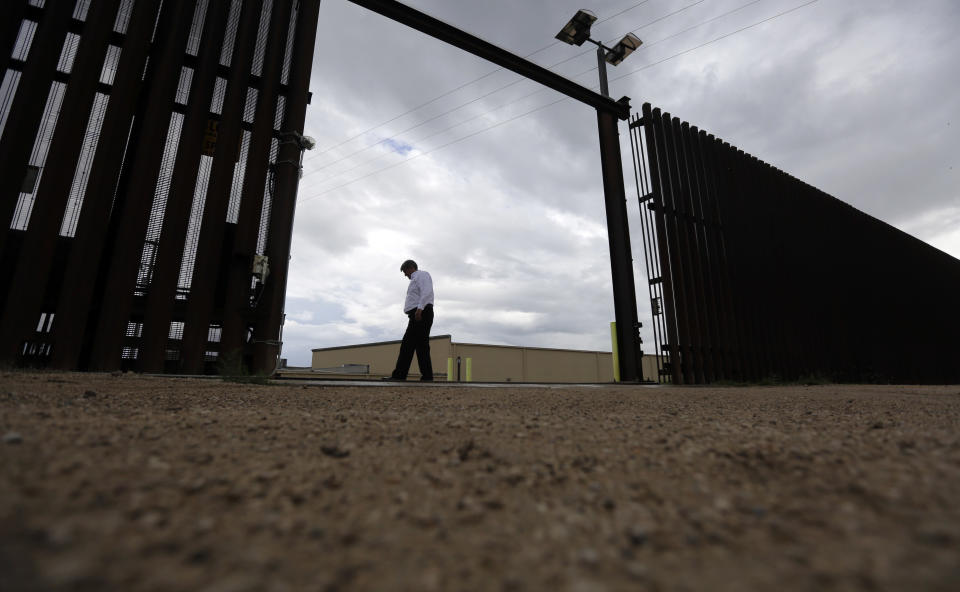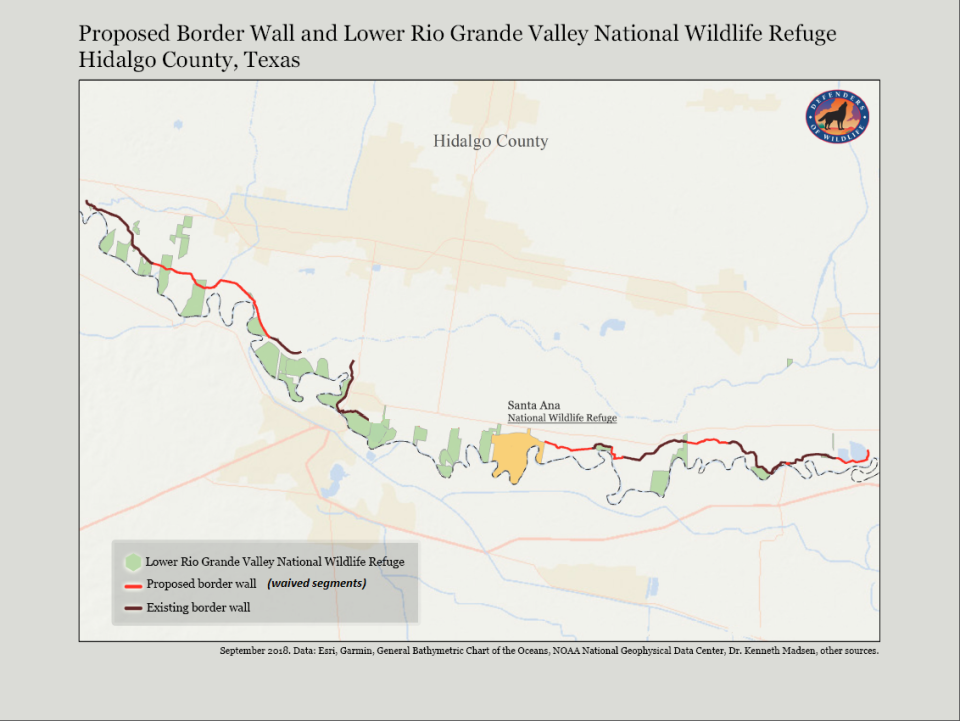Trump administration sued over border wall waiver of environmental protections

In the effort to build President Trump’s “big, beautiful border wall,” the Department of Homeland Security (DHS) issued itself a waiver that allows it to ignore dozens of laws intended to preserve the natural environment along the border between the United States and Mexico.
Three environmental groups — the Center for Biological Diversity (CBD), the Animal Legal Defense Fund and Defenders of Wildlife — filed a lawsuit Thursday against the Trump administration in U.S. District Court in Washington, D.C., arguing that the DHS does not have the authority to waive current environmental laws for a forthcoming construction aimed at closing a substantial number of gaps along a 14-mile section of existing border wall in Hidalgo County, in Texas’s Rio Grande Valley.
On Oct. 10, DHS announced the waiver “to ensure the expeditious construction of gates” in Texas, a move that was predicated on the authority granted by Congress to the secretary of homeland security to secure the border.
Section 102 of 1996’s Illegal Immigration Reform and Immigrant Responsibility Act (IIRIRA) gives the secretary discretion to waive “all legal requirements” deemed necessary to install additional walls and roads near the border to deter illegal crossing in high-activity areas.
Anthony Eliseuson, a senior staff attorney at the Animal Legal Defense Fund, said it’s clear the law was designed for specific projects that Congress thought had been delayed for too long, not as a “blank check” for DHS.

“Homeland Security is saying, ‘We can use this waiver authority however we see fit at our sole discretion, and nobody can second-guess us.’ We have an argument that that is ultra vires, a legal term meaning it’s without statutory authority,” Eliseuson told Yahoo News.
The environmental groups also argue that the way the waiver authority was created by Congress violates various separation-of-power doctrines by essentially passing off what should be a congressional power to an administrative agency.
Carlos Diaz, a spokesman for Customs and Border Protection (CBP), said the new waiver will enable closing a substantial number of gaps along a 14-mile section of the border in Hidalgo County that had not been completed during construction of sections of border wall in 2008.
“Notwithstanding the waiver, CBP will implement sound environmental practices as part of the project covered by this waiver. CBP will utilize existing environmental data, perform additional environmental surveys, and use that information to assess potential impacts,” Diaz wrote in an email to Yahoo News.
Conservation groups argue that the U.S.-Mexico border wall will hinder wildlife migration — threatening endangered species. They also say that CBP has not held a single public forum or meeting where officials can talk about the border wall proposal with the community, despite repeated requests.

“They may have held some closed-door, private meetings with individual stakeholders. We were never invited to those,” Laiken Jordahl, a borderlands campaigner at CBD, told Yahoo News. “Most folks I know were never invited to those, and it’s really meaningless if they’re cherry-picking the stakeholders. It’s not really public consultation; it’s selective consultation.”
Citizens are free to share their opinions with DHS via email until Nov. 6, but the fact that this waiver was issued in the middle of a public comment period on the border wall is another sore point. Conservation groups had sent a letter in July to CBP requesting a 60-day extension, and the agency extended the window for comments.
“While DHS has waived various environmental laws, it remains committed to environmental stewardship,” Diaz said in response to criticism over the small window for citizens to lodge complaints. “As such, CBP continues to welcome the public’s input regarding potential impacts of this project and will utilize this information to evaluate the potential environmental impacts from the project, develop construction best management practices, and mitigate environmental impacts where feasible in an effort to eliminate or minimize impacts.”
The waiver applies to the addition of 11 automated wall gates and related improvements at the “PF225 Bollard Fence alignment,” an existing fence in the Rio Grande Valley at the southernmost tip of Texas — an area of frequent illegal crossings.
In 2017, the U.S. Border Patrol reported the apprehension of more than 137,000 people entering the country illegally in this area and seized roughly 260,000 pounds of marijuana and 1,192 pounds of cocaine. The Rio Grande Valley accounts for over 40 percent of apprehensions, making it the busiest area in the country. Border Patrol in the Rio Grande Valley said these crossings occur where it has insufficient infrastructure and technology.

According to the DHS statement, the agency remains “committed to environmental stewardship” despite opting out of various environmental protections. CBP shared a list with Yahoo News of 28 laws that DHS has waived, including the National Environmental Policy Act and the Endangered Species Act.
The Texas project will not include building a wall within the Santa Ana National Wildlife Refuge, a 2,088-acre sanctuary for migratory birds along the banks of the Rio Grande, DHS says. Its biological diversity led to its renown as “the jewel of the National Wildlife Refuge System.”
Nevertheless, the Center for Biological Diversity was not pleased that the route affected by the waiver runs directly through the Lower Rio Grande Valley National Wildlife Refuge and other nature preserves, as well as through agricultural lands and communities.
“If the agency was serious about environmental stewardship, they would follow the dozens of environmental laws that they have decided to waive. All of these laws are bedrock environmental protections. These are laws Congress has debated, deliberated on and passed. We all know how hard it is to get legislation passed by Congress,” Jordahl said.
According to CBD, the government has already seized land from private citizens in Cameron County to construct border barriers and 40 miles of border wall that divide communities and wildlife refuges.

CBD is also suing the Trump administration for using a “long-expired waiver” for separate wall construction at the Santa Teresa Port of Entry in New Mexico and appealing a federal court ruling in another lawsuit to stop a border wall replacement in San Diego.
Rep. Filemon Vela, D-Texas, who represents Brownsville, on the northern bank of the Rio Grande, released a statement on Oct. 15 condemning the Trump administration’s “reckless decision” to waive the environmental protections.
“Perhaps most troubling is that the Administration issued these waivers in the middle of a public comment period, blindsiding local officials, property owners and Congress, while steamrolling public input,” Vela said. “Despite thousands of members of the public formally weighing against the border wall proposal, it’s now clear that the Administration never intended to take these concerns seriously.”
Despite some political pushback, Joshua Blank, the manager of polling and research at the Texas Politics Project at the University of Texas at Austin, told Yahoo News it’s unlikely that the latest DHS waiver will have a major effect on the midterms for voters in the Lone Star State.
“I’m not sure that this will have any impact on the midterms,” Blank said. “It’s an ongoing story going back to Bush’s fence, but it’s not clear that it’s broadly penetrating beyond those who live directly on the border.”

_____
Read more from Yahoo News:
Khashoggi friend says journalist angered Saudi government with column
Facebook accused of conservative bias over Kavanaugh article fact-check
California’s ‘Queen of Green’ fights Trump to set stricter pollution rules
Lawyer for Stormy Daniels and Julie Swetnick wants the 2020 Democratic nomination
Photos: Honduran migrant caravan pushes north toward the U.S.
Hear the latest episode of Skullduggery, our podcast on scandals in the Trump era



